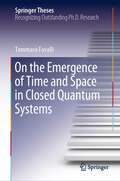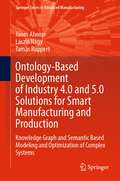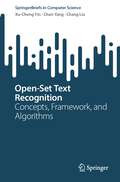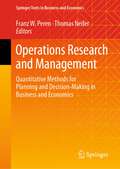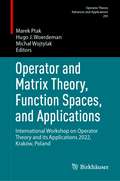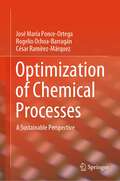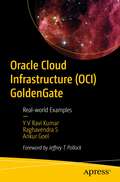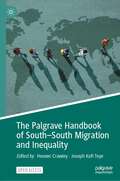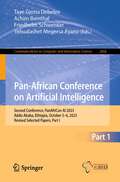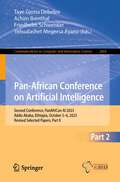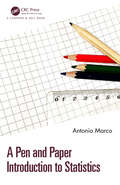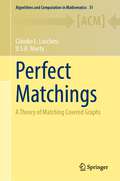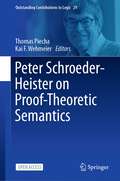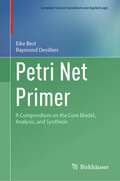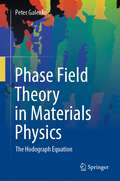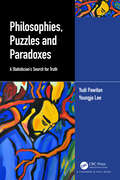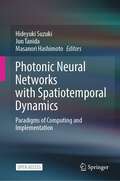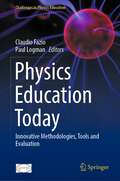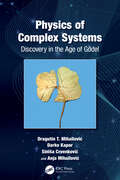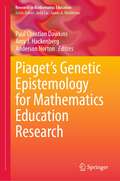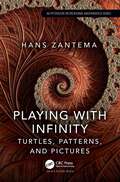- Table View
- List View
On the Emergence of Time and Space in Closed Quantum Systems (Springer Theses)
by Tommaso FavalliTime, space and entanglement are the main characters in this book. Their nature is still a great mystery in physics and we study here the possibility that these three phenomena are closely connected, showing how entanglement can be at the basis of the emergence of time and space within closed quantum systems. We revisit and extend the Page and Wootters theory that was originally introduced in order to describe the emergence of time through entanglement between subsystems in a globally static, quantum Universe. In the book, after providing a complete review of the salient aspects of the theory, we establish a connection with recent research on the foundations of statistical mechanics and we provide a new understanding of the thermalization process. Furthermore, we generalize the framework in order describe the spatial degree of freedom and we provide a model of 3+1 dimensional, quantum spacetime emerging from entanglement among different subsystems in a globally "timeless" and "positionless" Universe. Finally, via the Page and Wootters theory, the evolution of quantum clocks within a gravitational field is treated and a time dilation effect is obtained in agreement with the Schwarzschild solution.
Ontology-Based Development of Industry 4.0 and 5.0 Solutions for Smart Manufacturing and Production: Knowledge Graph and Semantic Based Modeling and Optimization of Complex Systems (Springer Series in Advanced Manufacturing)
by János Abonyi László Nagy Tamás RuppertThis book presents a comprehensive framework for developing Industry 4.0 and 5.0 solutions through the use of ontology modeling and graph-based optimization techniques. With effective information management being critical to successful manufacturing processes, this book emphasizes the importance of adequate modeling and systematic analysis of interacting elements in the era of smart manufacturing. The book provides an extensive overview of semantic technologies and their potential to integrate with existing industrial standards, planning, and execution systems to provide efficient data processing and analysis. It also investigates the design of Industry 5.0 solutions and the need for problem-specific descriptions of production processes, operator skills and states, and sensor monitoring in intelligent spaces. The book proposes that ontology-based data can efficiently represent enterprise and manufacturing datasets. The book is divided into two parts: modeling and optimization. The semantic modeling part provides an overview of ontologies and knowledge graphs that can be used to create Industry 4.0 and 5.0 applications, with two detailed applications presented on a reproducible industrial case study. The optimization part of the book focuses on network science-based process optimization and presents various detailed applications, such as graph-based analytics, assembly line balancing, and community detection. The book is based on six key points: the need for horizontal and vertical integration in modern industry; the potential benefits of integrating semantic technologies into ERP and MES systems; the importance of optimization methods in Industry 4.0 and 5.0 concepts; the need to process large amounts of data while ensuring interoperability and re-usability factors; the potential for digital twin models to model smart factories, including big data access; and the need to integrate human factors in CPSs and provide adequate methods to facilitate collaboration and support shop floor workers.
Open-Set Text Recognition: Concepts, Framework, and Algorithms (SpringerBriefs in Computer Science)
by Xu-Cheng Yin Chun Yang Chang LiuIn real-world applications, new data, patterns, and categories that were not covered by the training data can frequently emerge, necessitating the capability to detect and adapt to novel characters incrementally. Researchers refer to these challenges as the Open-Set Text Recognition (OSTR) task, which has, in recent years, emerged as one of the prominent issues in the field of text recognition. This book begins by providing an introduction to the background of the OSTR task, covering essential aspects such as open-set identification and recognition, conventional OCR methods, and their applications. Subsequently, the concept and definition of the OSTR task are presented encompassing its objectives, use cases, performance metrics, datasets, and protocols. A general framework for OSTR is then detailed, composed of four key components: The Aligned Represented Space, the Label-to-Representation Mapping, the Sample-to-Representation Mapping, and the Open-set Predictor. In addition,possible implementations of each module within the framework are discussed. Following this, two specific open-set text recognition methods, OSOCR and OpenCCD, are introduced. The book concludes by delving into applications and future directions of Open-set text recognition tasks.This book presents a comprehensive overview of the open-set text recognition task, including concepts, framework, and algorithms. It is suitable for graduated students and young researchers who are majoring in pattern recognition and computer science, especially interdisciplinary research.
Operations Research and Management: Quantitative Methods for Planning and Decision-Making in Business and Economics (Springer Texts in Business and Economics)
This textbook introduces quantitative methods in operations management, based on operational research. Written for undergraduate and graduate students as well as practitioners, this book serves as a valuable compendium of essential tools for project planning, control, and strategic decision-making.Drawing from the expertise of both experienced scientists and seasoned practical managers, the descriptions of each tool are a harmonious blend of theoretical insights and real-world applicability. With a focus on accessibility, the authors have thoughtfully combined abstract concepts with easy-to-follow examples and detailed case studies.Readers will benefit from the abundance of well-explained recommendations and practical problem-solving approaches, where the book offers guidance on how to solve presented issues by using commercial software. Whether one seeks to refine project management, optimize operations, or make strategic choices, this book equips readers with the knowledge and proficiency required to excel in the dynamic field of operations management.
Operator and Matrix Theory, Function Spaces, and Applications: International Workshop on Operator Theory and its Applications 2022, Kraków, Poland (Operator Theory: Advances and Applications #295)
by Marek Ptak Hugo J. Woerdeman Michał WojtylakThis volume features presentations from the International Workshop on Operator Theory and its Applications that was held in Kraków, Poland, September 6-10, 2022. The volume reflects the wide interests of the participants and contains original research papers in the active areas of Operator Theory. These interests include weighted Hardy spaces, geometry of Banach spaces, dilations of the tetrablock contractions, Toeplitz and Hankel operators, symplectic Dirac operator, pseudodifferential and differential operators, singular integral operators, non-commutative probability, quasi multipliers, Hilbert transform, small rank perturbations, spectral constants, Banach-Lie groupoids, reproducing kernels, and the Kippenhahn curve. The volume includes contributions by a number of the world's leading experts and can therefore be used as an introduction to the currently active research areas in operator theory.
Optimization of Chemical Processes: A Sustainable Perspective
by José María Ponce-Ortega Rogelio Ochoa-Barragán César Ramírez-MárquezThis textbook introduces readers to a comprehensive framework for the application of deterministic optimization strategies in the field of chemical processes, with a strong emphasis on sustainability.The book establishes a vital connection between fundamental deterministic optimization principles, optimization tools, and real-world application instances, all within the context of environmentally responsible practices. The approach put forth in this book is exceptionally versatile, allowing for the use of many optimization software and deterministic techniques.Contained in the book are many fundamental optimization concepts, encompassing linear programming, nonlinear programming, integer programming, and multi-objective optimization, all tailored to promote sustainable decision-making. Furthermore, the book provides practical examples illustrating the application of these techniques within sustainable chemical processes as tutorials.The textbook also explores the utilization of popular optimization software platforms such as GAMS, MATLAB, and Python, demonstrating how these tools can be leveraged for eco-friendly process optimization. Through this comprehensive framework, readers can not only acquire the skills needed to optimize a wide range of processes but also learn how to do so with sustainability at the forefront of their considerations. This approach streamlines the optimization process, eliminating unnecessary complications along the way and ensuring that environmental and ethical considerations are integral to the decision-making process.
Oracle Cloud Infrastructure (OCI) GoldenGate: Real-world Examples
by Y V Ravi Kumar Raghavendra S Ankur GoelThis book focuses on the utilization of GoldenGate Services (GGS) in conjunction with a microservices architecture on the Oracle cloud (OCI), primarily for data migration and integration across various data sources and targets.The book begins with a practical example of utilizing GGS on a Marketplace VM, progressively advancing to in-depth discussions on implementing GoldenGate as a Service on OCI. The book offers illustrative guides for data replication between RDBMSs (such as Oracle, Postgres, and big data targets such as Kafka). Additionally, it explores monitoring techniques using Enterprise Manager and Grafana dashboards. A comparative analysis is presented between traditional VM-based GoldenGate installations and the OCI service model. Special attention is given to Zero Downtime Migration (ZDM) and leveraging GGS for database migration from on-premises to OCI. Some chapters address multi-cloud replication using OCI GGS and include real-life case studies.By the end of this book you will have gained comprehensive insights into the architectural design of GoldenGate Services and will be adept at replicating data using GGS, enabling you to replicate setups in your own environments.What You Will LearnSet up GoldenGate Services for high availability (HA), disaster recovery (DR), migration of data to cloud, and moving data into the data lake or lakehousePerform logical migration of data to the cloud using the ZDM tool (ZDM uses GoldenGate internally).Replicate data to big data targetsMonitor GGS using Enterprise Manager and GrafanaReplicate data in a multi-cloud environment Who This Book Is ForOracle database administrators who want to replicate data or use Oracle GoldenGate Services for migration and setup of high availability (HA) and disaster recovery (DR); and data engineers who want tobuild the data warehouse, data lake, data lakehouse to push data in near real-time
The Palgrave Handbook of South–South Migration and Inequality
by Heaven Crawley Joseph Kofi TeyeThis open access handbook examines the phenomenon of South-South migration and its relationship to inequality in the Global South, where at least a third of all international migration takes place. Drawing on contributions from nearly 70 leading migration scholars, mainly from the Global South, the handbook challenges dominant conceptualisations of migration, offering new perspectives and insights that can inform theoretical and policy understandings and unlock migration’s development potential. The handbook is divided into four parts, each highlighting often overlooked mobility patterns within and between regions of the Global South, as well as the inequalities faced by those who move. Key cross-cutting themes include gender, race, poverty and income inequality, migration decision making, intermediaries, remittances, technology, climate change, food security and migration governance. The handbook is an indispensable resource on South-South migration and inequality for academics, researchers, postgraduates and development practitioners.
Pan-African Conference on Artificial Intelligence: Second Conference, PanAfriCon AI 2023, Addis Ababa, Ethiopia, October 5–6, 2023, Revised Selected Papers, Part I (Communications in Computer and Information Science #2068)
by Taye Girma Debelee Achim Ibenthal Friedhelm Schwenker Yehualashet Megersa AyanoThis two-volume set, CCIS 2068 and 2069, constitutes selected papers presented during the Second Pan-African Conference on Artificial Intelligence, PanAfriCon AI 2023, held in Addis Ababa, Ethiopia, in October 2023. The set goal of the conference is to exchange the best practices of joint Pan-African efforts to provide solutions for Africa’s key 21st century challenges in the social, economic and ecologic domains. The 29 papers were thoroughly reviewed and selected from 134 submissions. The papers are organized in the following topical sections: Medical AI; Natural Language Processing, Text and Speech Processing; AI in Finance and Cyber Security; Autonomous Vehicles; AI Ethics and Life Sciences.
Pan-African Conference on Artificial Intelligence: Second Conference, PanAfriCon AI 2023, Addis Ababa, Ethiopia, October 5–6, 2023, Revised Selected Papers, Part II (Communications in Computer and Information Science #2069)
by Taye Girma Debelee Achim Ibenthal Friedhelm Schwenker Yehualashet Megersa AyanoThis two-volume set, CCIS 2068 and 2069, constitutes selected papers presented during the Second Pan-African Conference on Artificial Intelligence, PanAfriCon AI 2023, held in Addis Ababa, Ethiopia, in October 2023. The set goal of the conference is to exchange the best practices of joint Pan-African efforts to provide solutions for Africa’s key 21st century challenges in the social, economic and ecologic domains. The 29 papers were thoroughly reviewed and selected from 134 submissions. The papers are organized in the following topical sections: Medical AI; Natural Language Processing, Text and Speech Processing; AI in Finance and Cyber Security; Autonomous Vehicles; AI Ethics and Life Sciences.
A Pen and Paper Introduction to Statistics
by Antonio MarcoStatistics is central in the biosciences, social sciences and other disciplines, yet many students often struggle to learn how to perform statistical tests, and to understand how and why statistical tests work. Although there are many approaches to teaching statistics, a common framework exists between them: starting with probability and distributions, then sampling from distribution and descriptive statistics and later introducing both simple and complex statistical tests, typically ending with regression analysis (linear models). This book proposes to reverse the way statistics is taught, by starting with the introduction of linear models. Today, many statisticians know that the one unifying principle of statistical tests is that most of them are instances of linear models. This teaching method has two advantages: all statistical tests in a course can be presented under the same unifying framework, simplifying things; second, linear models can be expressed as lines over squared paper, replacing any equation with a drawing. This book explains how and why statistics works without using a single equation, just lines and squares over grid paper. The reader will have the opportunity to work through the examples and compute sums of squares by just drawing and counting, and finally evaluating whether observed differences are statistically significant by using the tables provided. Intended for students, scientists and those with little prior knowledge of statistics, this book is for all with simple and clear examples, computations and drawings helping the reader to not only do statistical tests but also understand statistics.
A Pen and Paper Introduction to Statistics
by Antonio MarcoStatistics is central in the biosciences, social sciences and other disciplines, yet many students often struggle to learn how to perform statistical tests, and to understand how and why statistical tests work. Although there are many approaches to teaching statistics, a common framework exists between them: starting with probability and distributions, then sampling from distribution and descriptive statistics and later introducing both simple and complex statistical tests, typically ending with regression analysis (linear models). This book proposes to reverse the way statistics is taught, by starting with the introduction of linear models. Today, many statisticians know that the one unifying principle of statistical tests is that most of them are instances of linear models. This teaching method has two advantages: all statistical tests in a course can be presented under the same unifying framework, simplifying things; second, linear models can be expressed as lines over squared paper, replacing any equation with a drawing. This book explains how and why statistics works without using a single equation, just lines and squares over grid paper. The reader will have the opportunity to work through the examples and compute sums of squares by just drawing and counting, and finally evaluating whether observed differences are statistically significant by using the tables provided. Intended for students, scientists and those with little prior knowledge of statistics, this book is for all with simple and clear examples, computations and drawings helping the reader to not only do statistical tests but also understand statistics.
Perfect Matchings: A Theory of Matching Covered Graphs (Algorithms and Computation in Mathematics #31)
by Cláudio L. Lucchesi U.S.R. MurtyBeginning with its origins in the pioneering work of W.T. Tutte in 1947, this monograph systematically traces through some of the impressive developments in matching theory. A graph is matchable if it has a perfect matching. A matching covered graph is a connected graph on at least two vertices in which each edge is covered by some perfect matching. The theory of matching covered graphs, though of relatively recent vintage, has an array of interesting results with elegant proofs, several surprising applications and challenging unsolved problems. The aim of this book is to present the material in a well-organized manner with plenty of examples and illustrations so as to make it accessible to undergraduates, and also to unify the existing theory and point out new avenues to explore so as to make it attractive to graduate students.
Peter Schroeder-Heister on Proof-Theoretic Semantics (Outstanding Contributions to Logic #29)
This open access book is a superb collection of some fifteen chapters inspired by Schroeder-Heister's groundbreaking work, written by leading experts in the field, plus an extensive autobiography and comments on the various contributions by Schroeder-Heister himself. For several decades, Peter Schroeder-Heister has been a central figure in proof-theoretic semantics, a field of study situated at the interface of logic, theoretical computer science, natural-language semantics, and the philosophy of language. The chapters of which this book is composed discuss the subject from a rich variety of angles, including the history of logic, the proper interpretation of logical validity, natural deduction rules, the notions of harmony and of synonymy, the structure of proofs, the logical status of equality, intentional phenomena, and the proof theory of second-order arithmetic. All chapters relate directly to questions that have driven Schroeder-Heister's own research agenda and to which he has made seminal contributions. The extensive autobiographical chapter not only provides a fascinating overview of Schroeder-Heister's career and the evolution of his academic interests but also constitutes a contribution to the recent history of logic in its own right, painting an intriguing picture of the philosophical, logical, and mathematical institutional landscape in Germany and elsewhere since the early 1970s. The papers collected in this book are illuminatingly put into a unified perspective by Schroeder-Heister's comments at the end of the book. Both graduate students and established researchers in the field will find this book an excellent resource for future work in proof-theoretic semantics and related areas.
Petri Net Primer: A Compendium on the Core Model, Analysis, and Synthesis (Computer Science Foundations and Applied Logic)
by Eike Best Raymond DevillersPetri nets model concurrent and distributed systems where active components communicate through the production and absorption of various kinds of resources. Although the dynamic properties of such systems may be very complex, they may sometimes be connected to the static structure of a Petri net. Many properties are decidable, but their complexity may be huge. It is often opportune to restrict oneself to classes of systems, to partial algorithms, and to similar but simpler properties. Instead of analysing a given system, it is also possible to search for a system satisfying some desired properties by construction. This comprehensive textbook/reference presents and discusses these issues in-depth in the context of one of the most fundamental Petri net models, called place/transition nets. The presentation is fortified by means of many examples and worked exercises. Among topics addressed: • In which order may actions may be generated and scheduled? • What states and configurations may be reached in a concurrent system? • Which interesting classes of systems can be analysed relatively efficiently? • Is it possible to synthesise a system of some class from its behaviour? • How can systems be represented algebraically, compositionally, and concisely? This unique text, based on introductory as well as on advanced courses on distributed systems, will serve as an invaluable guide for students and (future) researchers interested in theoretical—as well as in practical—aspects of Petri nets and related system models. Eike Best has been a full professor (now retired) affiliated to Carl von Ossietzky Universität Oldenburg, Germany. Raymond Devillers has been a full professor (now retired) affiliated to Université Libre de Bruxelles, Belgium. The authors have a long record as collaborators in the fields of Petri nets and the semantics of concurrency.
Phase Field Theory in Materials Physics: The Hodograph Equation
by Peter GalenkoThis book deals with the use of the hodograph equation in phase transformations in condensed matter, especially, for crystallization and solidification processes. The main focus of the book is the interpretation of the phase-field equations for isotropic and anisotropic interfaces based on the advanced Gibbs–Thomson and Herring conditions, respectively. Beginning with the basic ideas behind the extended irreversible thermodynamics, the kinetic phase-field model for slow and arbitrarily fast phase transformations is derived where the unified hodograph equation follows from:• the sharp interface limit of the diffuse interface or• the traveling wave solution of the propagating phase field.Under the example of solute trapping and disorder trapping effects, comparing theoretical results with molecular dynamics simulations, and with the analysis of experimental data, the concrete workability of the developed hodograph equation is demonstrated for widest range of driving force in phase transformations.
Philosophies, Puzzles and Paradoxes: A Statistician’s Search for Truth
by Yudi Pawitan Youngjo LeeUnlike mathematics, statistics deals with real-world data and involves a higher degree of subjectivity due to the role of interpretation. Interpretation is shaped by context as well as the knowledge, preferences, assumptions and preconceptions of the interpreter, leading to a variety of interpretations of concepts as well as results. Philosophies, Puzzles and Paradoxes: A Statistician’s Search for Truth thoroughly examines the distinct philosophical approaches to statistics – Bayesian, frequentist and likelihood – arising from different interpretations of probability and uncertainty. These differences are highlighted through numerous puzzles and paradoxes and illuminated by extensive discussions of the background philosophy of science.Features: Exploration of the philosophy of knowledge and truth and how they relate to deductive and inductive reasoning, and ultimately scientific and statistical thinking Discussion of the philosophical theories of probability that are wider than the standard Bayesian and frequentist views Exposition and examination of Savage’s axioms as the basis of subjective probability and Bayesian statistics Explanation of likelihood and likelihood-based inference, including the controversy surrounding the likelihood principle Discussion of fiducial probability and its evolution to confidence procedure Introduction of extended and hierarchical likelihood for random parameters, with the recognition of confidence as extended likelihood, leading to epistemic confidence as an objective measure of uncertainty for single events Detailed analyses and new variations of classic paradoxes, such as the Monty Hall puzzle, the paradox of the ravens, the exchange paradox, and more Substantive yet non-technical, catering to readers with only introductory exposure to the theory of probability and statistics This book primarily targets statisticians in general, including both undergraduate and graduate students, as well as researchers interested in the philosophical basis of probability and statistics. It is also suitable for philosophers of science and general readers intrigued by puzzles and paradoxes.
Philosophies, Puzzles and Paradoxes: A Statistician’s Search for Truth
by Yudi Pawitan Youngjo LeeUnlike mathematics, statistics deals with real-world data and involves a higher degree of subjectivity due to the role of interpretation. Interpretation is shaped by context as well as the knowledge, preferences, assumptions and preconceptions of the interpreter, leading to a variety of interpretations of concepts as well as results. Philosophies, Puzzles and Paradoxes: A Statistician’s Search for Truth thoroughly examines the distinct philosophical approaches to statistics – Bayesian, frequentist and likelihood – arising from different interpretations of probability and uncertainty. These differences are highlighted through numerous puzzles and paradoxes and illuminated by extensive discussions of the background philosophy of science.Features: Exploration of the philosophy of knowledge and truth and how they relate to deductive and inductive reasoning, and ultimately scientific and statistical thinking Discussion of the philosophical theories of probability that are wider than the standard Bayesian and frequentist views Exposition and examination of Savage’s axioms as the basis of subjective probability and Bayesian statistics Explanation of likelihood and likelihood-based inference, including the controversy surrounding the likelihood principle Discussion of fiducial probability and its evolution to confidence procedure Introduction of extended and hierarchical likelihood for random parameters, with the recognition of confidence as extended likelihood, leading to epistemic confidence as an objective measure of uncertainty for single events Detailed analyses and new variations of classic paradoxes, such as the Monty Hall puzzle, the paradox of the ravens, the exchange paradox, and more Substantive yet non-technical, catering to readers with only introductory exposure to the theory of probability and statistics This book primarily targets statisticians in general, including both undergraduate and graduate students, as well as researchers interested in the philosophical basis of probability and statistics. It is also suitable for philosophers of science and general readers intrigued by puzzles and paradoxes.
Photonic Neural Networks with Spatiotemporal Dynamics: Paradigms of Computing and Implementation
by Hideyuki Suzuki Jun Tanida Masanori HashimotoThis open access book presents an overview of recent advances in photonic neural networks with spatiotemporal dynamics. The computing and implementation paradigms presented in this book are outcomes of interdisciplinary studies by collaborative researchers from the three fields of nonlinear mathematical science, information photonics, and integrated systems engineering. This book offers novel multidisciplinary viewpoints on photonic neural networks, illustrating recent advances in three types of computing methodologies: fluorescence energy transfer computing, spatial-photonic spin system, and photonic reservoir computing. The book consists of four parts: Part I introduces the backgrounds of optical computing and neural network dynamics; Part II presents fluorescence energy transfer computing, a novel computing technology based on nanoscale networks of fluorescent particles; Parts III and IV review the models and implementation of spatial-photonic spin systems and photonic reservoir computing, respectively. These contents are beneficial to researchers in a broad range of fields, including information science, mathematical science, applied physics, and engineering, to better understand the novel computing concepts of photonic neural networks with spatiotemporal dynamics.
Physics Education Today: Innovative Methodologies, Tools and Evaluation (Challenges in Physics Education)
by Claudio Fazio Paul LogmanThis book provides an in-depth exploration of the latest developments in physics education. It presents a comprehensive look into cutting-edge research and ideas used to improve physics education around the world. Topics covered include (but are not limited to) the use of problem-based learning, the design and evaluation of teaching materials, and the use of digital technologies. This book is essential for anyone looking to stay up-to-date on the latest educational innovations and to develop an understanding of effective teaching approaches. It is aimed at researchers, teachers, students, policymakers, and educational leaders in the field of physics education.
Physics of Complex Systems: Discovery in the Age of Gödel
by Dragutin T. Mihailović Darko Kapor Siniša Crvenković Anja MihailovićThis book analyses the physics of complex systems to elaborate the problems encountered in teaching and research. Inspired by the of Kurt Gödel (including his incompleteness theorems) it considers the concept of time, the idea of models and the concept of complexity before trying to assess the state of physics in general. Using both general and practical examples, the idea of information is discussed, emphasizing its physical interpretation, debates ideas in depth using examples and evidence to provide detailed considerations on the topics. Based on the authors’ own research on these topics, this book puts forward the idea that the application of information measures can provide new results in the study of complex systems. Helpful for those already familiar with the concepts who wish to deepen their critical understanding, Physics of Complex Systems will be extremely valuable both for people that are already involved in complex systems and also readers beginning their journey into the subject. This work will encourage readers to follow and continue these ideas, enabling them to investigate the various topics further.
Physics of Complex Systems: Discovery in the Age of Gödel
by Dragutin T. Mihailović Darko Kapor Siniša Crvenković Anja MihailovićThis book analyses the physics of complex systems to elaborate the problems encountered in teaching and research. Inspired by the of Kurt Gödel (including his incompleteness theorems) it considers the concept of time, the idea of models and the concept of complexity before trying to assess the state of physics in general. Using both general and practical examples, the idea of information is discussed, emphasizing its physical interpretation, debates ideas in depth using examples and evidence to provide detailed considerations on the topics. Based on the authors’ own research on these topics, this book puts forward the idea that the application of information measures can provide new results in the study of complex systems. Helpful for those already familiar with the concepts who wish to deepen their critical understanding, Physics of Complex Systems will be extremely valuable both for people that are already involved in complex systems and also readers beginning their journey into the subject. This work will encourage readers to follow and continue these ideas, enabling them to investigate the various topics further.
Piaget’s Genetic Epistemology for Mathematics Education Research (Research in Mathematics Education)
by Paul Christian Dawkins Amy J. Hackenberg Anderson NortonThe book provides an entry point for graduate students and other scholars interested in using the constructs of Piaget’s genetic epistemology in mathematics education research. Constructs comprising genetic epistemology form the basis for some of the most well-developed theoretical frameworks available for characterizing learning, particularly in mathematics. The depth and complexity of Piaget’s work can make it challenging to find adequate entry points for learners, not least because it requires a reorientation regarding the nature of mathematical knowledge itself. This volume gathers leading scholars to help address that challenge. The main section of the book presents key Piagetian constructs for mathematics education research such as schemes and operations, figurative and operative thought, images and meanings, and decentering. The chapters that discuss these constructs include examples from research and address how these constructs can be used in research. There are two chapters on various types of reflective abstraction, because this construct is Piaget’s primary tool for characterizing the advancement of knowledge. The later sections of the book contain commentaries reflecting on the contributions of the body of theory developed in the first section. They connect genetic epistemology to current research domains such as equity and the latest in educational psychology. Finally, the book closes with short chapters portraying how scholars are using these tools in specific arenas of mathematics education research, including in special education, early childhood education, and statistics education.
Playing with Infinity: Turtles, Patterns, and Pictures (AK Peters/CRC Recreational Mathematics Series)
by Hans ZantemaThis is a book about infinity - specifically the infinity of numbers and sequences. Amazing properties arise, for instance, some kinds of infinity are argued to be greater than others. Along the way the author will demonstrate how infinity can be made to create beautiful ‘art’, guided by the development of underlying mathematics. This book will provide a fascinating read for anyone interested in number theory, infinity, math art, and/or generative art, and could be used a valuable supplement to any course on these topics.Features: Beautiful examples of generative art Accessible to anyone with a reasonable high school level of mathematics Full of challenges and puzzles to engage readers
Playing with Infinity: Turtles, Patterns, and Pictures (AK Peters/CRC Recreational Mathematics Series)
by Hans ZantemaThis is a book about infinity - specifically the infinity of numbers and sequences. Amazing properties arise, for instance, some kinds of infinity are argued to be greater than others. Along the way the author will demonstrate how infinity can be made to create beautiful ‘art’, guided by the development of underlying mathematics. This book will provide a fascinating read for anyone interested in number theory, infinity, math art, and/or generative art, and could be used a valuable supplement to any course on these topics.Features: Beautiful examples of generative art Accessible to anyone with a reasonable high school level of mathematics Full of challenges and puzzles to engage readers
